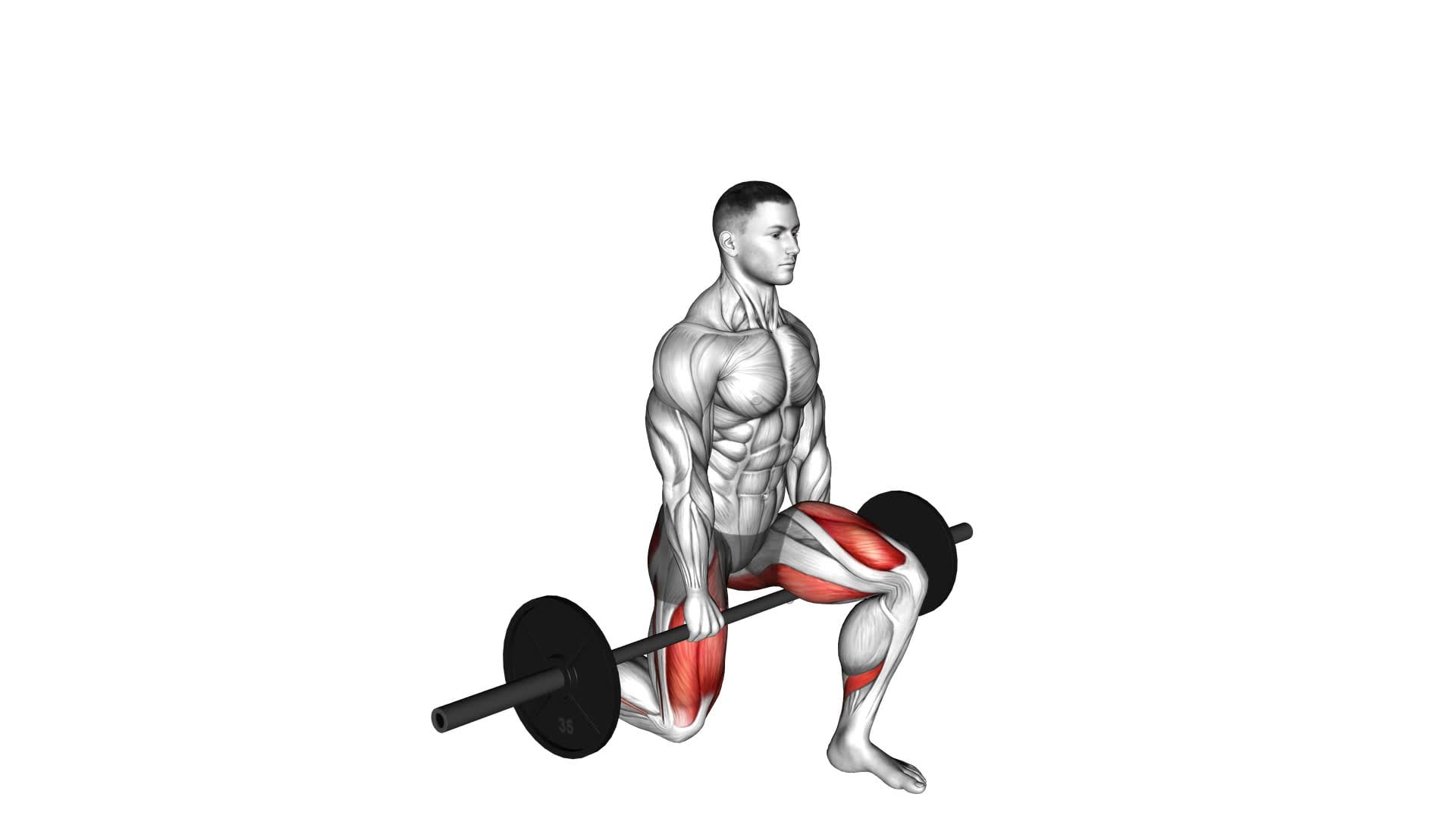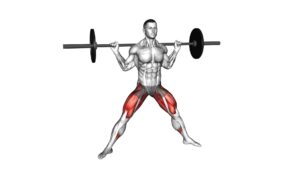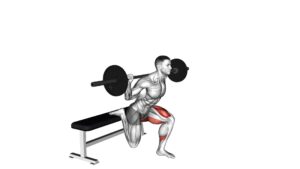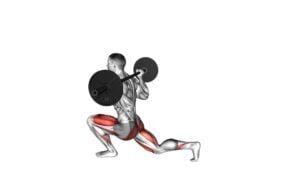Barbell Split Squat (VERSION 2) – Video Exercise Guide & Tips

Are you looking to take your leg training to the next level? Then the Barbell Split Squat (Version 2) is the exercise for you!
Watch This Exercise Video
In this video exercise guide, we will show you proper form and technique, variations and progressions, common mistakes to avoid, and tips for incorporating this challenging exercise into your workout routine.
Get ready to strengthen and sculpt your legs like never before with the Barbell Split Squat (Version 2)!
Key Takeaways
- Barbell Split Squat targets multiple muscle groups simultaneously, including quadriceps, hamstrings, glutes, and calves.
- It improves lower body strength, stability, and functional movement patterns.
- Engaging core muscles, feet, and ankles enhances stability, balance, and coordination.
- Increasing weight, trying variations, and incorporating tempo variations can help progress and increase intensity while maintaining proper form and technique.
Benefits of Barbell Split Squat (Version 2)
When performing the Barbell Split Squat (Version 2), you can experience a range of benefits that result from engaging multiple muscle groups and improving your lower body strength and stability.
One of the main benefits of the Barbell Split Squat (Version 2) is its ability to target multiple muscle groups simultaneously. This exercise primarily works your quadriceps, hamstrings, glutes, and calves. By engaging these muscles, you can develop greater overall lower body strength, which can improve your performance in various activities, such as running, jumping, and lifting.
Additionally, the Barbell Split Squat (Version 2) can help to improve your stability and balance. By performing this exercise, you challenge your core muscles as well as the muscles in your feet and ankles. This can enhance your ability to maintain proper form and stability during other exercises or daily activities.
Furthermore, the Barbell Split Squat (Version 2) offers modifications that can be tailored to your fitness level. You can adjust the amount of weight you use, the depth of your lunge, and even incorporate additional equipment, such as a stability ball or resistance bands, to increase the intensity of the exercise.
Proper Form and Technique for Barbell Split Squat (Version 2)
To properly execute the Barbell Split Squat (Version 2), focus on maintaining a stable and balanced position throughout the exercise. This will help you maximize the benefits and avoid injury.
When performing the Barbell Split Squat (Version 2), there are a few modifications you can make to suit your fitness level. One option is to start with bodyweight only, gradually adding weights as you become more comfortable and confident with the exercise. Another modification is to use dumbbells instead of a barbell, which can provide more stability and control during the movement.
In terms of equipment options, you can use a barbell or dumbbells for the Barbell Split Squat (Version 2). The choice depends on your preference and availability. If using a barbell, make sure it's securely placed on your upper back, resting on your traps. If using dumbbells, hold one in each hand, with your arms by your sides.
Remember to maintain proper form throughout the exercise. Keep your chest up, shoulders back, and core engaged. Step forward with one foot and lower your back knee towards the ground, ensuring your front knee stays in line with your ankle. Push through your front heel to return to the starting position.
Variations and Progressions for Barbell Split Squat (Version 2)
To increase the challenge and continue progressing with your Barbell Split Squat (Version 2), you can incorporate various variations and advanced techniques.
These variations and progressions will help target different muscle groups and intensify your workout.
One variation you can try is the Bulgarian Split Squat, where you elevate your back foot on a bench or step. This variation places more emphasis on the front leg, increasing the demand on your quadriceps and glutes.
Another variation is the Barbell Front Rack Split Squat, where you hold the barbell in the front rack position. This variation challenges your core stability and upper body strength while still working your lower body muscles.
To further progress your Barbell Split Squat, you can increase the weight by using heavier dumbbells or a heavier barbell. This will add more resistance and make the exercise more challenging.
Additionally, you can incorporate tempo variations, such as slowing down the eccentric (lowering) phase or adding a pause at the bottom of the movement.
Remember to always maintain proper form and technique when performing any variation or progression. Start with lighter weights and gradually increase the intensity as you become more comfortable and confident.
Common Mistakes to Avoid During Barbell Split Squat (Version 2)
To maximize your results and prevent injury, it's important to be aware of the common mistakes to avoid during the Barbell Split Squat (Version 2). By understanding these mistakes and implementing tips for improvement, you can ensure that you're performing the exercise correctly and getting the most out of your workout.
One common mistake to avoid is allowing your front knee to extend past your toes. This puts excessive strain on your knee joint and can lead to discomfort or injury. To prevent this, focus on keeping your weight in your heel and maintaining a vertical shin angle. This will help to properly engage your glutes and hamstrings.
Another mistake to watch out for is collapsing your back knee towards the floor. This can cause instability and put unnecessary stress on your knee joint. Instead, focus on keeping your back knee in line with your hip and ankle. This will help to maintain proper alignment and stability throughout the exercise.
Additionally, it's important to avoid rounding your back or hunching your shoulders during the Barbell Split Squat. This can compromise your form and lead to lower back pain. To correct this, keep your chest lifted and engage your core muscles throughout the movement.
Tips for Incorporating Barbell Split Squat (Version 2) Into Your Workout Routine
To effectively incorporate the Barbell Split Squat (Version 2) into your workout routine, you should focus on proper form and gradually increase the weight and intensity. This exercise targets your quadriceps, glutes, and hamstrings, helping to build lower body strength and stability.
Here are some tips for maximizing results with the Barbell Split Squat (Version 2):
- Start with lighter weights and master the proper form before increasing the load. This will help prevent injuries and ensure that you're targeting the correct muscles.
- Keep your front knee aligned with your ankle and avoid letting it go past your toes. This will help protect your knee joint and ensure proper alignment.
- Engage your core throughout the exercise to maintain stability and control.
- Focus on controlling the movement and avoid using momentum to lift the weight. This will help increase the effectiveness of the exercise and prevent cheating.
Incorporating the Barbell Split Squat (Version 2) into your workout routine can provide numerous benefits. It helps improve lower body strength and stability, enhances balance and coordination, and targets multiple muscle groups simultaneously. By following these tips and gradually increasing the weight and intensity, you can maximize your results and achieve your fitness goals.
Frequently Asked Questions
How Many Sets and Reps Should I Do for the Barbell Split Squat (Version 2)?
To determine the number of sets and reps for the barbell split squat (version 2), you need to consider your fitness goals and current ability level.
Barbell split squat variations offer various benefits, such as increased leg strength, stability, and muscle growth.
It's generally recommended to start with 2-3 sets of 8-12 reps per leg.
As you progress, you can gradually increase the intensity by adding more sets or reps.
Remember to listen to your body and adjust accordingly.
Can I Substitute the Barbell With Dumbbells or Kettlebells for This Exercise?
Yes, you can substitute the barbell with dumbbells or kettlebells for the split squat exercise. Using dumbbells or kettlebells can provide some advantages such as increased stability and balance due to the separate weights.
However, it may also limit the amount of weight you can use compared to a barbell. It's important to choose a weight that challenges you while maintaining proper form.
Be mindful of any limitations or discomfort when using different equipment.
Is It Normal to Feel a Burn in the Front Leg During the Barbell Split Squat (Version 2)?
Yes, it's normal to feel a burn in the front leg during the barbell split squat (version 2). This exercise targets your quads, glutes, and hamstrings.
To perform it with proper form and technique, start by placing one foot in front of the other and lowering your body until your front thigh is parallel to the ground.
To increase the difficulty, you can add more weight to the barbell or perform the exercise on an unstable surface like a balance board.
Can Beginners Perform the Barbell Split Squat (Version 2) or Is It More Suitable for Advanced Lifters?
Beginners can definitely perform the barbell split squat (version 2). It's a great exercise to incorporate into your workout routine.
You can start with lighter weights or even just bodyweight, gradually increasing the weight as you get stronger.
This exercise helps to build lower body strength, improve balance, and target multiple muscle groups.
It's important to focus on proper form and technique to avoid injury. Seek guidance from a qualified trainer to ensure you're performing the exercise correctly and safely.
Are There Any Modifications or Alternatives for Individuals With Knee or Hip Issues?
If you have knee or hip issues, there are modifications and alternatives available for the barbell split squat. These modifications can help reduce stress on your joints while still providing a challenging workout.
For example, you can try using a lighter weight or performing the exercise without any weight at all.
Additionally, you can explore alternative exercises like lunges or step-ups, which target the same muscles while putting less strain on your knees and hips.
Conclusion
In conclusion, the barbell split squat (version 2) is a highly effective exercise that targets the lower body muscles, particularly the quadriceps and glutes. By maintaining proper form and technique, individuals can benefit from increased strength, stability, and muscle development.
Variations and progressions can be incorporated to challenge and progress the exercise. However, it's important to avoid common mistakes to prevent injury.
Incorporating the barbell split squat (version 2) into your workout routine can enhance overall lower body strength and improve athletic performance.

Author
Years ago, the spark of my life’s passion ignited in my mind the moment I stepped into the local gym for the first time. The inaugural bead of perspiration, the initial endeavor, the very first surge of endorphins, and a sense of pride that washed over me post-workout marked the beginning of my deep-seated interest in strength sports, fitness, and sports nutrition. This very curiosity blossomed rapidly into a profound fascination, propelling me to earn a Master’s degree in Physical Education from the Academy of Physical Education in Krakow, followed by a Sports Manager diploma from the Jagiellonian University. My journey of growth led me to gain more specialized qualifications, such as being a certified personal trainer with a focus on sports dietetics, a lifeguard, and an instructor for wellness and corrective gymnastics. Theoretical knowledge paired seamlessly with practical experience, reinforcing my belief that the transformation of individuals under my guidance was also a reflection of my personal growth. This belief holds true even today. Each day, I strive to push the boundaries and explore new realms. These realms gently elevate me to greater heights. The unique combination of passion for my field and the continuous quest for growth fuels my drive to break new ground.



